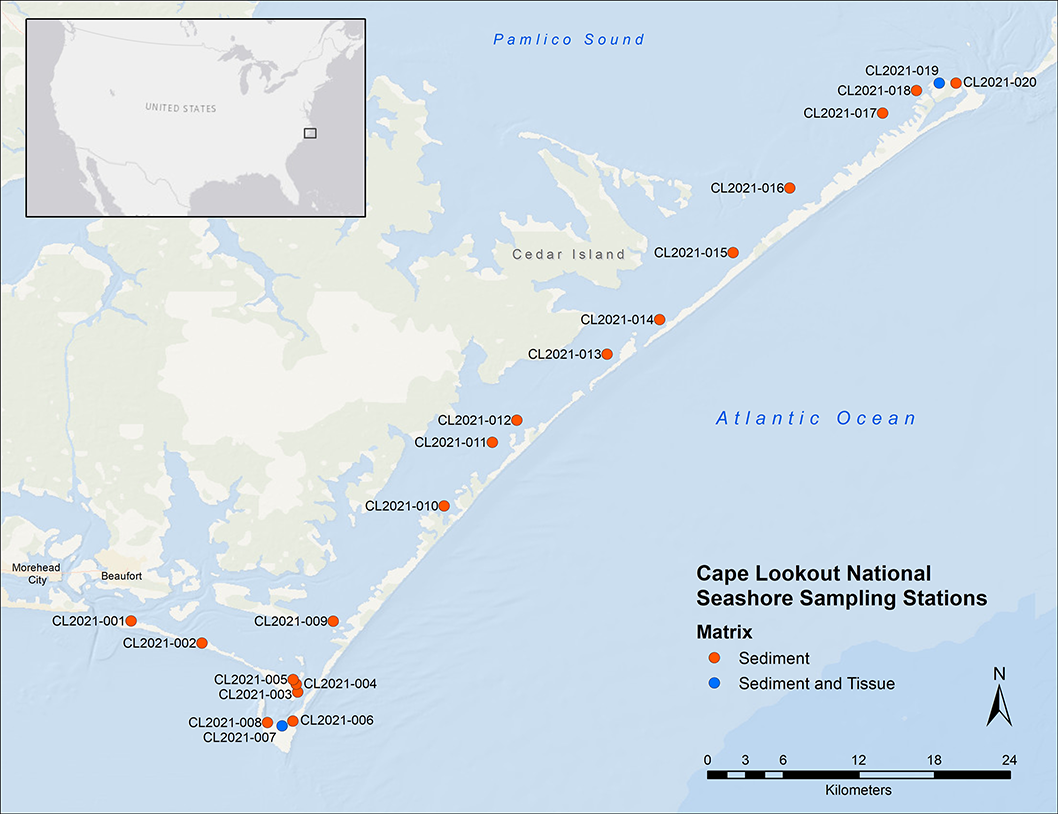In 2018, Hurricane Florence caused historic flooding in North and South Carolina, potentially affecting coastal environmental quality in the region due to salinity changes and redistributed contaminants and bacterial pathogens. We assessed water and sediment quality within Cape Lookout National Seashore to determine the storm's environmental impact on the Outer Banks. The information will help natural resource managers and coastal communities assess ecosystem vulnerabilities and provide baseline data to track coastal environmental changes in the region.
Why We Care
Land-based runoff upstream of Cape Lookout National Seashore is suspected of having chemical and bacterial contaminants from industrial and agricultural activities. The scale of coastal flooding caused by hurricanes could be enough to carry such contaminants to the Outer Banks, posing a health risk to the national park's visitors and its ecosystem. Park managers will use water and sediment quality data from this project to guide actions that protect public health and the environment.
What We Did and Are Doing
The research team collected water, sediment, and oysters from 20 sites along the Cape Lookout National Seashore. The NCCOS Charleston Laboratory analyzed the water samples for nutrients and chlorophyll a and the sediment samples for the following contaminants: 22 metals, 80 pharmaceuticals and personal care products, 17 human hormones, 50 polycyclic aromatic hydrocarbons (PAHs), 4 alkylphenols, and 25 pesticides. TDI Brooks and B&B Laboratories are measuring perfluorooctane sulfonic acid (PFOS) compounds in the sediment and oyster tissue samples.
What We Found
Nutrient and chlorophyll a levels in water samples from the 20 sites did not exceed any available water quality standards. All of the pharmaceutical and personal care products (PPCPs) and human hormones chosen for analysis in the sediment samples were below the method detection limit. Of the 25 pesticides measured, only three pesticides were detected (4,4'-DDD, heptachlor epoxide, cis-chlordane), but only one each at five different sites. Sediment was analyzed for four alkylphenols, but only one was detected (4-n-octylphenol) and at four different sites. PAHs were detected at 18 of the 20 sites. Of the 22 metals measured, 13 were found at all 20 sites. Three of the metals (silver, cadmium, antimony) were not found at any site. Metals were detected in the highest amounts at sites CL2021-019 and CL2021-020. At both of these sites, 19 metals were detected. Results from PFOS analysis of sediments are forthcoming. Results from oyster tissue analysis are also forthcoming.
Benefits of Our Work
Project data will help natural resource managers and coastal communities assess regional ecosystem vulnerabilities and provide baseline data to track coastal environmental changes.

Map of Cape Lookout National Seashore sampling sites. Credit: Mary Rider, NOAA.
 Official websites use .gov
A .gov website belongs to an official government organization in the United States.
Official websites use .gov
A .gov website belongs to an official government organization in the United States. Secure .gov websites use HTTPS
A lock or https:// means you’ve safely connected to the .gov website. Share sensitive information only on official, secure websites.
Secure .gov websites use HTTPS
A lock or https:// means you’ve safely connected to the .gov website. Share sensitive information only on official, secure websites.